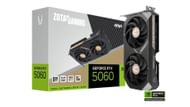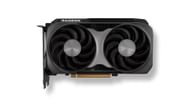The Nvidia RTX 5060 and AMD RX 9060 XT are among the latest launches in the market. They are targeting entry-level 1080p and 1440p gaming with the latest improvements in rendering technology that improve the 60-class' value proposition. However, both Green and Red teams have pros and cons this generation, with pricing and availability concerns making it difficult to choose between them.
To help you navigate the sub-$350 market, we have compiled a deep dive into the two GPUs' architecture, on-paper specs, and gaming performance. Read on to find out how they stack against each other.
Note: Some aspects of this article are subjective and solely reflect the writer's opinions.
Both Nvidia RTX 5060 and RX 9060 XT 16 GB bring competitive gaming performance, with caveats

The RTX 5060 is an iterative improvement over last year's RTX 4060. It brings slightly improved rasterization and ray tracing performance while staying faithful to the market position the 60-class represents. Meanwhile, the 9060 XT is much more ambitious than the last generation. AMD has positioned it to be the most powerful mid-range GPU.
Read more: 5 best mid-range CPUs for the Nvidia RTX 5060
Specs comparison
In terms of on-paper specs, we can't directly compare the Nvidia and AMD cards, given they're based on wildly different architectures. Regardless, a look at the on-paper details reveals what to expect from the GPUs.
With the 5060, you get 3,840 CUDA cores and 30 RT cores, a slight increase from the last-gen RTX 4060. While you can't compare the specs, the 9060 XT 16 GB bundles 32 Compute Units, which translates to higher raw rasterization capabilities.
The VRAM capacity stays similar at 8 GB; however, it is faster GDDR7 standard. This totals to 448 GB/s in bandwidth, up from the 9060 XT's 320 GB/s since the AMD card is limited to GDDR6.
The extra hardware in the RX 9060 XT makes it a slightly better GPU. It packs 25.6 TFLOPS of rendering prowess while the 5060 got 19.2 TFLOPS, a 33% difference. The difference doesn't translate quite linearly, however.
The detailed specs are as follows:
In terms of pricing, the RTX 5060 has the upper hand: $299 vs the $349 9060 XT 16 GB. This can be a significant difference for entry-level gamers who don't have the extra money to splurge on a GPU.
Performance comparison

Performance is a real deal for most gamers, with minor differences not influencing the final decision much. In this regard, both cards have their pros and cons: ray tracing, upscaling, and frame generation being Nvidia's strong suits, with AMD trading blows in raw rendering capabilities and VRAM capacity.
Here's a side-by-side look at the performance numbers achieved by the two GPUs. We sourced the framerate metrics from Testing Games.
Across the board, the RTX 5060 scores a geomean of 69.2 FPS at 1080p, while the AMD card gets 75.6 FPS (9.7% lead). At 1440p, the 5060 gets 46.9 FPS, while the 9060 XT sits at 50.1 FPS (7.6% lead).
The 9060 XT does struggle in games such as Ghost of Tsushima and Horizon Forbidden West; however, it manages to maintain a lead across all settings and workloads. Even in ray-tracing-heavy games, the AMD card is better than the 5060.
At $349, the RX 9060 XT represents much better value. Its 16 GB VRAM helps future-proof the GPU for 1440p gaming while also being faster in terms of raw compute. However, the RTX 5060 is $50 cheaper and comes with multi-frame generation, which is yet to be widely implemented in AMD's FSR.
We recommend opting for the AMD RX 9060 XT if you want to future-proof your rig. Multi-frame generation should be out on Team Red cards in the near future, and the extra video memory gives you peace of mind.
